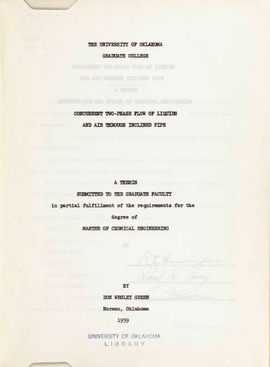| dc.contributor.author | Green, Don Wesley | |
| dc.date.accessioned | 2017-08-28T16:21:16Z | |
| dc.date.available | 2017-08-28T16:21:16Z | |
| dc.date.issued | 1959 | |
| dc.identifier.uri | https://hdl.handle.net/11244/51937 | |
| dc.description.abstract | The concurrent flow of two phases through a pipe has been the object of increased study in recent years as a result of its recognized importance. It is well established that when a liquid phase and a gas phase flow simultaneously through a pipe, the resulting pressure drop is greater than if only a single phase were flowing. Under certain conditions, this "two-phase" pressure drop is further significantly increased when the flow is uphill. Knowledge of gas-liquid two-phase flow is therefore essential to solution of problems arising in such areas as natural gas transmission, oil production gathering systems, heat exchangers, and flow reactors. | |
| dc.description.abstract | In transporting fluids over level terrain, the sound economies of using a single pipe line to carry two phases have been well established in a number of cases. This is seen, for instance, in many of the oil field gathering systems along the Gulf Coast of the United States. However, in hilly country this result may not necessarily hold true. Liquid tends to accumulate in the low places with resulting energy dissipation in "slugging" on the inclines. At low gas rates there may be a slippage of part of the liquid back down an incline. Energy expended in raising the liquid up a hill is not regained on the downhill side as in single phase flow, which means that each hill is a source of pressure loss even though the ends of the pipe line may be at the same level. Due to these factors, it can be shown that there is an optimum line size for given fluid flow rates up a designated incline. That is, for two-phase flow in hilly country, a pipe line can be oversized just as readily as it can be undersized. | |
| dc.description.abstract | While much experimental work has been conducted in the field of two-phase flow, nearly all design work must still be done using an empirical approach. The problem of measuring factors such as interfacial height and roughness, velocity gradients, and energy expended in transporting and accelerating the liquid piase have made the experimental approach based upon theoretical studies very difficult. A further complication arises from the fact that one or a combination of several distinct types of flow my occur in the two-phase system depending upon such variables as fluid flow rates, fluid physical properties, pipe characteristics, etc. | |
| dc.description.abstract | The major portion of past experimental work bas been carried out in horizontal pipe. A lesser number of investigations has been made in vertical pipe, and very few studies made of flow in inclined pipe. Brigham and Holstein (9) observed the flow types and resulting pressure drops occurring at inclines of 5.5_nd 12.4_ith the horizontal. Flanigan (12) obtained and correlated field data taken from a two-phase pipe line through hilly country, and Baker (3), Berry and Moreau (7) have suggested design procedures to calculate the pressure drop in inclined flow. | |
| dc.description.abstract | This research was undertaken to make an additional study of pressure drops encountered in inclined flow and to compare the results with horizontal two-phase flow, vertical two-phase flow, and other available inclined flow data. Experimental runs were made with the pipe in a horizontal position and at angles of 2.3_nd 33_ith the horizontal. | |
| dc.description.abstract | It was also felt that data relating the q_antity of fluids flowing to the quantity of fluids "in-place" in the pipe would be useful. This was obtained by shutting-in the system and collecting and weighing the liquid in-place in the pipe during a number of designated experimental runs. | |
| dc.description.abstract | As an aid to further qualitative understanding of two-phase flow, the experimental system was made of clear plastic pipe in order that flow patterns could be observed. High speed movies (800 frames/second) and normal speed movies were taken of the flow with the pipe in the horizontal and inclined positions. These movies are available on loan from the School of Chemical Engineering, The University of Oklahoma. | |
| dc.format | vi, 77 leaves : ill. ; 29 cm.. | |
| dc.language | en_US | |
| dc.subject | Fluid mechanics | |
| dc.title | Concurrent two-phase flow of liquids and air through inclined pipe | |
| dc.type | Thesis | |
| dc.type | text | |
| dc.date.manuscript | 1959 | |
| dc.thesis.degree | Master of Chemical Engineering | |
| dc.note | Includes bibliographical references (leaves 72-73) | |
| dc.note | High speed movies (800 frames/second) and normal speed movies were taken of the flow with the pipe in the horizontal and inclined positions. These movies are available on loan from the School of Chemical Engineering, The University of Oklahoma. | |
| ou.group | College of Engineering::School of Chemical Engineering | |
